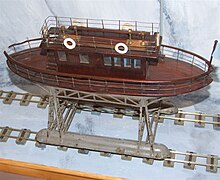Magnus Volk
Magnus Volk | |
|---|---|
 Magnus Volk, copyright Royal Pavilion & Museums, Brighton & Hove. | |
| Born | 19 October 1851 Brighton, Sussex, United Kingdom |
| Died | 20 May 1937 (aged 85) Brighton, Sussex, United Kingdom |
| Resting place | St. Wulfran's Church, Ovingdean, Sussex |
| Nationality | British |
| Spouse | Anna Volk (Banfield) |
| Children | Magnus Herman Volk, George Herbert Volk, Cecil Volk, Gordon Volk, Edgar Volk, Conrad Volk, Muriel May Volk |
| Parent(s) | Magnus Volk, Sarah Volk (Maynard) |
| Engineering career | |
| Discipline | Electrical, Mechanical |
| Institutions | Imperial Institute |
| Projects | Volk's Electric Railway, Brighton and Rottingdean Seashore Electric Railway |
| Awards | Order of Osmali |
Magnus Volk FII (1851–1937) was a British-German inventor and pioneering electrical engineer.
He is most notable for having built Volk's Electric Railway, the world's oldest operating electric railway.[1]
Career[edit]
Aside from the Volk's Electric Railway, he also built the unique but short-lived Brighton and Rottingdean Seashore Electric Railway, together with its unusual Daddy Long Legs vehicle.[2] He also built another short-lived line, similar to the VER, in the pleasure grounds at Aston Hall, Birmingham.[1]
In 1887 he attracted attention in Brighton by building a three-wheeled electric carriage powered by an Immisch motor. In 1888 he built another electric car, this time a four-wheeled carriage which was made to the order of the Sultan of the Ottoman Empire,[3] for which he was awarded an Order of Osmali, presented to Magnus by the Sultan in person whilst in Constantinople.[4]

Other projects of Magnus included inventing a fire-alarm system, early successful attempts at electricity in the home, telecommunications and installing electricity to the Royal Pavilion for the first time.[4]


Personal life[edit]
Magnus Volk was the son of a German clockmaker and was born on 19 October 1851 in Brighton. He lived at 38 Dyke Road in Brighton. On 8 April 1879, he married Anna Banfield in Burgess Hill. George Herbert Volk, his second son, is noted as a pioneer builder of seaplanes, whilst another son, Conrad Volk, wrote a biography of his father.[4] His descendants include the musician Joe Volk and the journalist Scott Campbell.[5]
Magnus Volk died in Brighton on 20 May 1937, and is buried at St Wulfran's churchyard in Ovingdean near Brighton.[6]
References[edit]
- ^ a b Jackson, Alan (1993). Volk's Railways Brighton. Plateway Press. ISBN 1-871980-18-6.
- ^ See Lee, Charles E., "Magnus Volk and His Railways," The Railway Magazine (UK), April 1942, at 116-17.
- ^ Georgano, G.N. Cars: Early and Vintage, 1886-1930. (London: Grange-Universal, 1985).
- ^ a b c Volk, Conrad. Magnus Volk of Brighton. (London: Phillimore, 1971).
- ^ "Magnus Volk". Retrieved 31 January 2024.
- ^ Dale, Antony (1989). Brighton Churches. London: Routledge. p. 207. ISBN 0-415-00863-8.
Bibliography[edit]
- Conrad Volk: Magnus Volk of Brighton. London & Chichester: Phillimore, 1971.
External links[edit]
- Magnus Volk in My Brighton and Hove site
- Volks Pioneer Animation on YouTube of 'Daddy Longlegs' seashore electric railway
